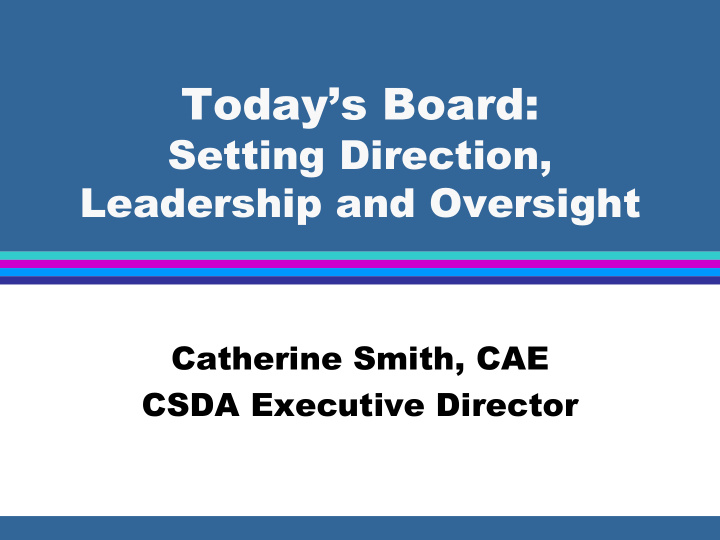



Today’s Board: Setting Direction, Leadership and Oversight Catherine Smith, CAE CSDA Executive Director
The very essence of a free government consists in considering offices as public trusts, bestowed for the good of the country, and not for the benefit of an individual or a party. John C. Calhoun John C. Calhoun
Effective Board Members ● Recognize and respect differences of perspective and style on the board and among staff and the community ● Govern with dignity and understand the implications of demeanor and behavior ● Realize it is more important how you govern than what you say ● Keep confidential matters confidential
Effective Board Members are Prepared ● They: • Do their homework • Work hard • Commit the time and energy to be effective • Think about the future and understand trends and the needs of the constituents (clients they serve)
Governance I to We (without losing me)
Governance ● Balancing act ● Governing board team ● Constituency ● My own values and beliefs
Governance ● The act of transforming the needs, wishes and desires of the community into policies that direct the community’s institutions.
An Effective Team ● Unity of Purpose ● Role of the Board ● Board Culture ● Structure and Process
The Board’s Responsibilities ● Set the direction ● Establish structure ● Provide support ● Ensure accountability ● Act as leaders
Setting Direction ● Energizes the board and staff ● Unifies the entity ● Links your entity to your constituents (clients)
Terms and Concepts to Clarify the Process of Setting Direction ● Vision ● Beliefs ● Strategic goals ● Success indicators
Vision ● A vision statement describes the future state toward which the Board is moving the entity. ● Also referred to as a mission statement.
Beliefs ● Beliefs are shared values and ideas that guide the entity.
Strategic Goals ● These are the specific achievements that must be accomplished to meet the entity’s vision.
Success Indicators ● Success indicators are the specific measures of the strategic goals that must be accomplished to meet the entity’s visions. ● Success indicators are measurable.
The Mindset of the Board Member ● Visionary thinking ● Strategic thinking ● Understanding the real mission
Understanding Roles Understanding Roles G over nance Team Bel i ef s Vi si on Pr i or i t i es Pol i ci es Strategic Goals Strategic Goals t H a Success Indicators Success Indicators o h w W St r at egi es Tact i cs Techni ques Adm i ni st r at i on & St af f
Board Member Transition ● I to We ● Unity of Purpose
The function of leadership is to produce more leaders, not more followers. Ralph Nader
External Leadership ● Understand why it is important ● Understand the various roles ● Have a community plan ● Media relations ● Legislative Advocacy
Community Leadership is Important ● Information ● Education ● Responsiveness ● Maintaining trust ● Board members must view themselves as ambassadors for their entity. ● Oversight and Accountability
Managing the Manager ● Directors should also be professionals ● Dissatisfied with performance – verify and handle with professionalism ● Be specific when asking for information ● Provide an annual evaluation
Board’s Role in Planning and Managing Change ● Establish the district’s mission and vision • Identify core values and ideas to guide the entity • Agree on what the future of the entity should be
Board’s Role in Planning and Managing Change ● Develop strategic plan, goals & objectives • Evaluate the present • Anticipate future – what will it look like in 5 or 10 years • Establish goals for accomplishing your plan • Review plan periodically and adjust
Board’s Role in Setting Policy ● Policies are written statements specifying the manner in which the entity’s business (basic operations and management) is conducted. • Board’s role: maintain, revise and enforce • Provide direction for staff and constituents
Board’s Role in Setting Policy ● Polices should not: • Undermine initiative and dissent • Promote timid, reactive and rule-bound public officials • Invite an excessive narrowing of concern or legalism • Ignore the discretion that public officials must exercise • Over-represent the interest of special interest groups
Board’s Role in Fiscal Issues ● Develop an annual budget ● Ensure adequate funding to provide quality services ● Develop long-range plan to ensure fiscal stability ● Review and approve major financial decisions and program proposals
Board’s Role in Fiscal Issues ● Review and approve changes in investment guidelines and reserve policies ● Safeguard and approve changes in district assets ● Accountability to your constituents/client
Board’s Role in Legal Issues ● Only Board can bind entity contractually ● Know and comply with all laws ● Follow advice of legal counsel ● Remain uninvolved in day-to-day operations • A director is personally liable for his/her own actions or omissions • District is liable for the Board’s action
Basic Role in Personnel Matters ● Approve job descriptions and the entity’s organizational structure ● Approval personnel policies and MOUs ● Establish salary structure and benefits ● Hire a qualified administrator ● Delegate powers as necessary
Board’s Role in Resolving Personnel Problems ● Limited to grievances and/or meet & confer ● Be objective, set policy, give direction and support management ● Eliminate personal feelings in decisions
Conclusion ● Set direction, provide leadership and ensure accountability ● I to We ● Unity of Purpose ● Be a positive influence in your entity’s present and future endeavors
Recommend
More recommend